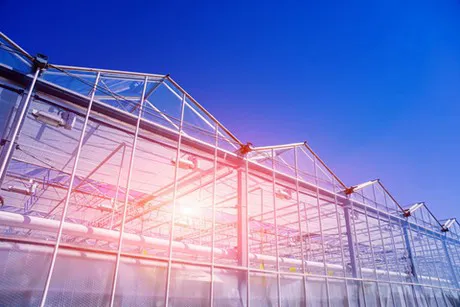All radiation from the sun, whether it is PAR light, UV or infrared, has an effect on the growth and production of crops. You can selectively manage it with coatings that increase the positive effects and inhibit the negative ones.

Less than 15% of the sun’s radiation is visible to us. Coincidentally, this largely corresponds with the region of the spectrum that plants use for photosynthesis. For a long time, we focused exclusively on managing the visible part of light. However, over the past ten years, our understanding of the whole spectrum has increased considerably. Consequently, we can now produce coatings that manage a much larger area of the spectrum, yielding better results in terms of production and quality.
PAR light
Visible light (wavelength 400 - 700 nm) virtually corresponds with the region of the spectrum that plants use for photosynthesis. This is why it is called photosynthetically active radiation. In short: PAR.
Not all colours result in equal levels of photosynthesis. Red is the most efficient colour, with efficiency decreasing as we move towards green, and peaking again with blue. This applies to individual leaves. Contrary to popular belief, at crop level, green light is actually just as efficient as blue.
The colour of the light also controls the shape and development of the crop. This often concerns the ratio between the colours. If there is more red compared to far red, the crop will grow more compact. This is also the case if there is more blue light compared to green.
UV radiation
In high doses, UV radiation (wavelength 280 - 400 nm) can suppress photosynthesis and cause visible damage to the crop. This is a very real danger in plastic greenhouses. UV-B (280-320 nm) is particularly responsible for this.
However, UV can also have positive effects. It improves the colouring of ornamental crops. And, very importantly, it improves their resistance to diseases.
Infrared and NIR
All radiation above a wavelength of 700 nm is called infrared. The first part is the short wavelength radiation, also known as heat radiation or near infrared (NIR, up to 2500 nm). The transition between light and infrared is formed by far red, a colour that our eyes can just about see. Far red is very important to plants, due to among other reasons its effect in plant stretching.
Although the plant does not use infrared for photosynthesis, it provides warmth to the plant. This can be highly desirable, but too much is never good. If the temperature of the plant increases too much, everything will go wrong: first it will stop photosynthesis, then irreparable damage will occur.
Managing with light
Nowadays we can selectively control all parts of the solar spectrum. Optifuse allows a better spread and penetration into the crop and therefore a better use of light. Eclipse reduces the level of radiation across the board. This may be necessary where there is high radiation, although it is often better to reflect heat radiation with Transpar, which allows you to retain the useful PAR light while preventing excess heating.
For more information: Sudlac Export
Sudlac Export
Stationsweg 31
1441 EJ Purmerend
The Netherlands
T + 31 (0)299 792 005
export@sudlac.com
www.sudlac.com
